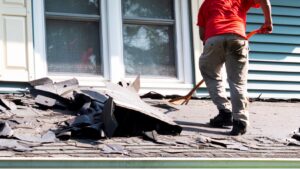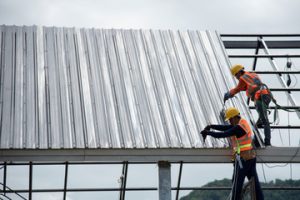Your roof can sustain serious damage from severe weather or from aging. It’s important to know whether repair or replacement is the right option for your home.
Water stains on your ceiling or walls are often an indicator of a leaky roof. Getting the problem repaired promptly can save your home from long-term structural issues. Visit bearsvalleyroofing.ca to learn more.

The weather is one of the most significant factors in roof repair, as it can make or break a roofing job. Rain and wind can cause a variety of issues, including water stains on ceilings and walls, leaks, and sagging areas.
The best time for roof repairs is when the weather is calm and dry. Working on a wet roof can be dangerous, and it can also lead to further damage to the roofing materials.
A complete roof inspection should be the first step before any work begins. A professional estimator should be able to examine every inch of your roof to identify problem areas and suggest the right repair solution.
If the damage is localized, like a few missing shingles or rusting flashing, a repair may be sufficient. Replacing a few shingles or fixing the metal flashing around chimneys, vents, and skylights can stop water from getting into your home and prevent larger problems down the line.
High winds can damage a roof by lifting or tearing off shingles, tiles, and other materials. A regular roof inspection and the use of impact-resistant shingles can help limit the effects of wind damage. In extreme cases, strong winds can even rip off sections of the roof itself.
Accessibility
It is important to have access to the materials needed for your roof repair. This can be done by renting a ladder, using safety ropes on steep roofs, or finding a safe way to access the roof from the ground. Other necessities include a hard hat, proper footwear (such as rubber-soled shoes), and adequate fall protection. Finally, make sure the roof is dry before beginning work. Moisture on a roof can interfere with the adhesion of repair materials and lead to premature wear. Begin by clearing the area around the damaged section. Clean the surface and remove any debris with a broom, brush, or air blower. Then, carefully cut a patch from a material that matches your roofing type and size. It is crucial that the patch covers all the damage and extends past the edges for maximum durability.
Materials
Choosing the right repair materials is an important part of maintaining the integrity and appearance of your home’s roof. Roofing materials need to be durable and resistant to a variety of climatic conditions. They also need to be compatible with existing roofing systems to ensure a watertight seal. Whether your roof is shingle, flat, or metal, it’s essential to find the best repair materials for the job.
To begin the roof leak repair process, locate the source of the leak and clean the area. This will help to prevent further water intrusion and damage. The next step is to apply a waterproof barrier. Ideally, you should choose a waterproof material that will be resistant to the same climatic conditions as your roof.
For example, if you have a metal roof, you should use a waterproof sealant that will protect the seams and fasteners from corrosion in cold climates. Similarly, if you have a shingle roof, you should use a tar-based waterproof material to stop leaks and keep rain out of your house.
Another option is to use roofing cement for minor repairs. This will quickly seal any cracks or holes, providing immediate relief from leaks. To apply roofing cement, simply scoop up a small amount with a putty knife or trowel and apply it to the damaged area. Be sure to press firmly into cracks and gaps to create a strong and effective seal.
If you want a more permanent solution to a leaky roof, consider patching. This will offer a more long-term solution and restore the integrity of your roof. Depending on the type of roofing you have, you may need to match the color and style of the new patch or replacement shingle.
Regardless of the type of roof repair you need, it’s important to take time to select the best repair materials. With the guidance of experts, homeowners in Marengo and Mount Vernon can confidently select and apply high-quality roofing repair products that will last for years. Contact Whitt Roofing & Restoration today to schedule a free inspection of your home’s roof.
Time
Your roof is one of the most important components of your home, protecting you and your belongings from harsh weather conditions. But like any other part of your house, your roof will eventually wear out and need to be repaired or replaced. Identifying and addressing issues early on can prevent costly damage in the future and reduce your overall repair costs.
If you are concerned about your home’s roof, a roof inspection may be necessary. This will involve assessing the condition of the roof, including checking for damage on both the inside and outside of the house. The inspection will also include inspecting the chimney, vents, gutters and downspouts to make sure they are in good working order.
The inspection process can take anywhere from a few hours to several days, depending on the extent of the work required. Minor repairs, such as replacing shingles or patching leaks, can typically be completed within a day. More extensive repairs, such as a full roof replacement or addressing structural problems, can take up to a week or more.
In most cases, roof repairs are less expensive than a full roof replacement. However, the upfront cost of a new roof can be intimidating, so it is important to weigh your options carefully. A new roof can add value and comfort to your home, as well as saving you money on recurring repair costs in the long run.
If your roof is under 15 years old and the damage is isolated – such as from a fallen tree branch or recent storm – then repairing it makes sense. Repairing a few missing or damaged shingles can stop water from entering the house and prevent more damage down the line.
Replacing flashing is another quick and easy way to prevent water infiltration. This involves swapping out old or damaged flashing and resealing the areas around chimneys, skylights, vents and other rooftop penetrations.
Roofing contractors can also replace damaged pipe boots, which protect the roof from rainwater and snow. This is a relatively fast and simple fix that requires minimal labor, and it can significantly reduce your energy bill by keeping heated or air-conditioned air from seeping out of your home.

